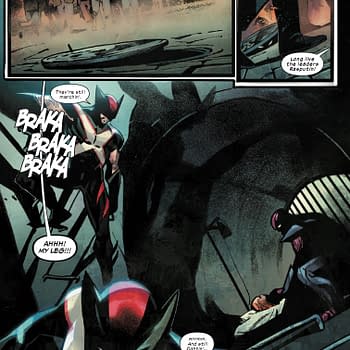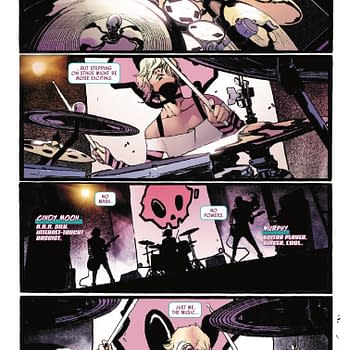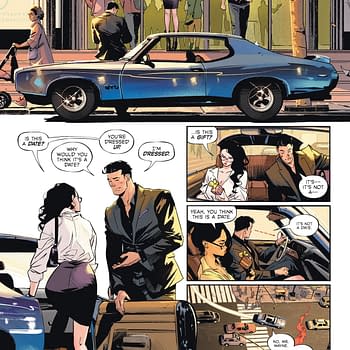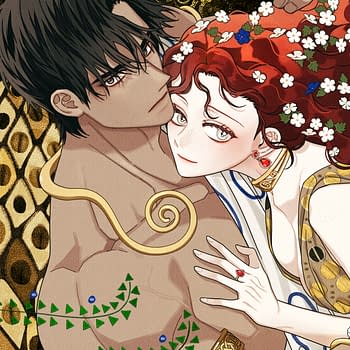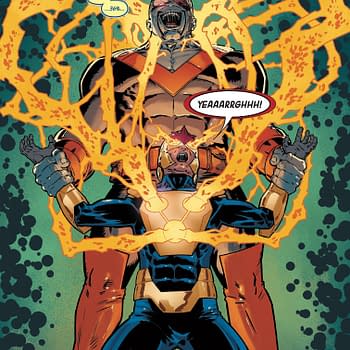Posted in: Comics | Tagged: Comics, dynamite, entertainment, Erik Mona, HRL, pathfinder, Roberto Castro, warlord of mars
Writer's Commentary – Erik Mona Talks Pathfinder Worldscape: Warlord of Mars
Dynamite has sent us a new writer's commentary, this one for a one-shot Pathfinder Worldscape: Warlord of Mars by Erik Mona. Cover and interiors by Roberto Castro.
* * * * *
Here's a look inside my head and some of the thinking that went into my script for the Pathfinder Worldscape: Warlord of Mars one-shot. This issue is part of four one-shot adventures spinning off of last year's Pathfinder Worldscape fantasy crossover six-issue series, with each issue in this new effort focusing on one of the main guest stars of that series: Red Sonja, Tarzan, and in this case, John Carter of Mars.
My work schedule kept me too busy to write all four one-shots, but there was no way I was going to let anyone else write the John Carter issue (or the Red Sonja one, but that's a tale for another day). The framework of the one-shots made them prequels, so I decided I might as well start at the very beginning and show how John Carter and Tars Tarkas came to the Worldscape, an interdimensional prison plane that draws in the greatest warriors of Earth, Barsoom, and Pathfinder's world of Golarion.
I also knew that the "out-of-time" element of the Worldscape allowed me to explore a bit of John Carter's past. It's always intrigued me that Carter was a Civil War veteran, and I figured it might be fun to give John a run-in with an old acquaintance from that little-explored era of his past. Overall I also wanted to keep the story lighter than the standard Worldscape issues, which are so tight with plot and character cameos that I sometimes ran out of room for longer, interesting action scenes. By the time I sat down to write this issue, I had about a dozen published comic scripts under my belt, and I try to use each one as an opportunity to better learn the craft. Pacing is a huge part of that challenge, and I explicitly wanted to fill this issue with less overall density, and let the art convey a simpler story than in most of my previous efforts.
I didn't know Roberto Castro would be illustrating the issue until after I finished it, but I was thrilled to find out. I've subsequently read a lot of his Dynamite work, and he's been at the center of some of their key events and storylines. It's an honor to have him draw my story. I'd also like to give a special shout-out to colorist Jorge Sutil, who brought a subdued palette highly suited to the story's old-timey elements.
Anyway, onto the commentary.
PAGE 1:
Here we have a cool establishing shot of John Carter and Tars Tarkas on their flier, having presumably just arrived via a portal from Barsoom to the Worldscape. They're still trying to get their bearings and understand what has happened to them. World-hopping may be a bit of a custom for Dynamite's version of John Carter, but it's still relatively new for Tars Tarkas.
The real appeal to me of these two characters is their interplay with one another. Burrough's version of John Carter is a hothead who brags of acting before he thinks as if it is a virtue. Tars Tarkas, who comes from an apparently more brutal culture, often serves as the voice of reason. This makes him a good straight man and a credible vehicle of exposition, as shown here.
Tars Tarkas's reference to the Sea of Omean and his awareness that the Barsoom-spanning religion of Issus and the Martian afterlife are cruel frauds dates this adventure to some time after the second Burroughs novel (and my personal favorite), The Gods of Mars, adapted by Dynamite in their Warlord of Mars comic.
Incidentally, I really like Castro's take on Green Martians here, which I think nicely echoes Jonathan Lau's take on Tars Tarkas in the main Pathfinder Worldscape series. With this and the green martians in Dynamite's latest Greatest Adventure Burroughs cross-over series, I feel like they've finally cracked the code to getting these creatures right visually speaking. I appreciate the early Dynamite John Carter comics for their faithfulness to the original novels, but the not-quite-canonical look of their Green Martians was always a kind of sticking point for me. I couldn't be happier with the way things are going with them visually across Dynamite's whole range right now.
PAGE 2-3:
I wanted to make sure that my two one-shots mixed up elements of all three worlds to keep things truly weird, which is what this dragon is all about. Giving the moment an entire two-page spread is part of spreading out the story a bit and giving the visuals more time to breathe, and Roberto certainly delivered with this powerhouse spread.
I'm still proud of the title "Rebels without a Planet" for this one.
PAGE 4-5:
Tars's comment that the dragon is "bigger than a malagor" is a reference to the legendary monstrous birds of Barsoom.
Other than that, Roberto's art speaks for itself. This sequence is again an effort to give the action more space to resolve. Page 3 has four large panels and page 4 has only three, giving Roberto more opportunity to give the aerial battle a sense of movement and scale.
PAGES 6-7:
Lots of nicely rendered sound effects in the second half of this battle sequence by letterer Tom Napolitano. I particularly appreciate the letterforms of the sputtering engine as Carter's flier plummets to the ground.
PAGE 8:
The fourth panel of this page clearly spells out that John Carter retains the super-strength gained as a result of the lower gravity of Mars while in the Worldscape. The magic of the prison dimension brings you in as you are on the world from which you are abducted. Otherwise John Carter would have normal strength and Tars Tarkas would collapse under his own weight. Which isn't very fun. So here it is explicitly—John Carter is super-strong in the Worldscape. Case closed!
PAGE 9:
I wish the eighth-ray engine Roberto drew on this page didn't look so much like a gun. I worry a that it might be a bit confusing, but them's the breaks in the wild world of comics. In my experience the artist improves on what I imagined in my head the vast, vast majority of times, so I've grown sanguine about the few times it doesn't quite come out the way I wanted. It still looks really cool!
Looking at this sequence I must say I really appreciate the way Roberto Castro captures Carter's physique. His Carter is realistically proportioned, which works with Sutil's colors to underscore a sort of realness to the whole offering that I think really suits the script.
John Carter was the vessel for one of the most human moments in the main Worldscape series, when he and the Pathfinder cleric Kyra discuss religion, so I like my Carter more human than super-human, all issues of strength and gravity aside.
The line "My mind is so constituted that I am subconsciously forced to act without recourse to second thought or misgivings" is a direct quote from the Burroughs books. As Burroughs relays Carter's adventures in first-person, you as the reader get a lot—and I mean a lot—of inner commentary about this act-first, think-later approach, so Tars Tarkas in panel three saying "Yes, I believe I have heard you mention that before" puts the Green Martian in the role of the reader of the Burroughs books, who might be forgiven for a bit of eye-rolling when Carter is at the height of his self-reverential rhapsodizing.
I love Burroughs and I love John Carter, but the gentleman from Virginia is not above lavishing praise upon himself, and I imagine even those closest to him might grow a bit tired of it from time to time.
PAGE 10:
John Carter as forensic crime scene analyst. Ha.
PAGE 11:
The creepy Confederate in the middle of the panel that looks like some kind of monster is a sea-spawn creature from Gail Simone's run on Red Sonja, which provides the Hyborian element for this issue (as does the later reference to the wizard Kulan Gath). Hey, I didn't say I needed a MAJOR element from each world, so this guy counts!
I do think, though, that the subdued color palette works against the script a bit here, as the sea-spawn in that Red Sonja arc (and the ill-fated sea-spawn Kelgeth from Pathfinder Worldscape #1) are all very colorful. Without a strong color I worry that this sea-spawn guy just looks like a regular monster.
And then I realize that no one but me really cares about these sorts of details, so I live with it. Anyone who truly cares about the sea-spawn will be well served by the issue's Pathfinder RPG rules appendix, which contains rules for playing them in the game. They're a highly customizable bunch, with plenty of fun options to choose from.
The whole page features more great art from Roberto. I like to think the phrase "the lowest, most dishonorable villain ever whipped out of the Confederate Army for unsavory conduct, degeneracy, and all-around loathsomeness" designates a really nasty individual, as I imagine the victor in that contest had some strong competition.
PAGE 12:
I wanted Zeb Cassidy to be a real son-of-a-bitch, still clinging to the language and concepts of his racist ideology, even when shunted to a world with a far greater—and far more terrifying—diversity than he was used to in the 1860s American South. He's an equal-opportunity undead racist Civil War officer, though—he thinks Texans are vermin, too.
PAGE 13:
For good measure, I made Zeb Cassidy a cannibal, too.
The last panel contains a couple of fun references. Kulan Gath, the wizard who animated Cassidy into eternal un-life, is of course Red Sonja's arch nemesis and the primary villain of the main Pathfinder Worldscape series.
The ten-legged tiger who killed Zeb originally is a Barsoomian banth similar to the one featured in Pathfinder Worldscape #2.
PAGE 14:
I'll die a little bit happier knowing I got to write the words "over yonder" in a comic script.
PAGE 15:
This page features the issue's "twist," where Carter and Tars retroactively reveal that they have the upper hand in anticipation of the issue's wrap-up. During the scripting of this issue, I found out that the scripts for these one-shots would be 16 pages, rather than the 18 I'd expected, and I ended up having to truncate this sequence more heavily than I would have liked. Even with an overall effort to space things out more leisurely than I'm used to, this sequence is still a bit too "tight" for my preference.
I dunno. I just read it again, and I think it works. I really like how Roberto uses the round panel 2 to draw attention to Carter pressing the button on the engine device. Thanks again for the assist, Roberto!
PAGE 16:
I would have liked another page for the final fight with the dragon, too, but reading it again I think the quick wrap-up works to pay off the pivot from the previous page.
I appreciate that I got a chance to end the story with the two of them laughing and having fun with one another. One of the things I love about John Carter is that he genuinely has FUN during his adventures. He gets a real thrill out of sword-fighting, exploration, and derring-do. He and Tars are truly friends. I love the idea that they're looking forward to what's around the next corner, especially because not too far down the line are the events of the main Pathfinder Worldscape series, in which they both play an important part!
And that's it for this issue. Thanks for reading all the way to the bottom. If you like this issue, please drop me a line @erikmona on Twitter!











